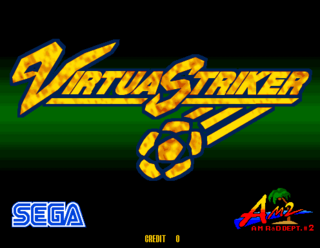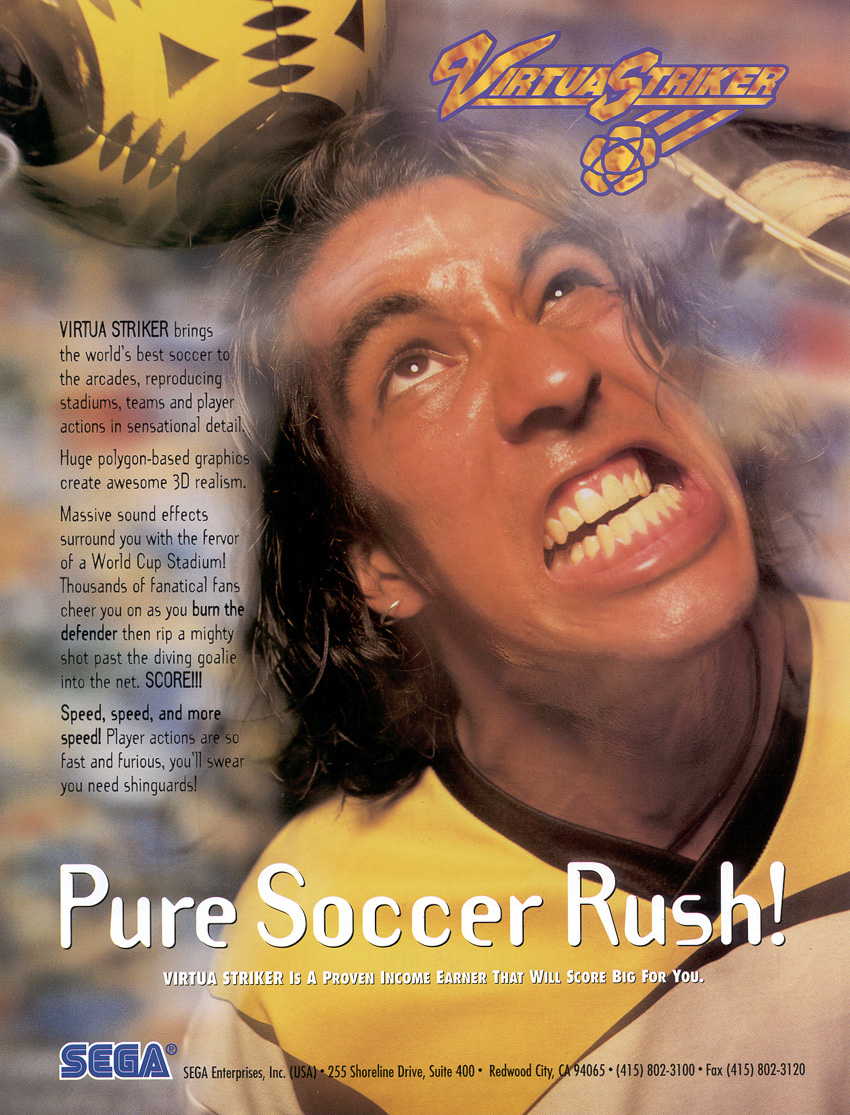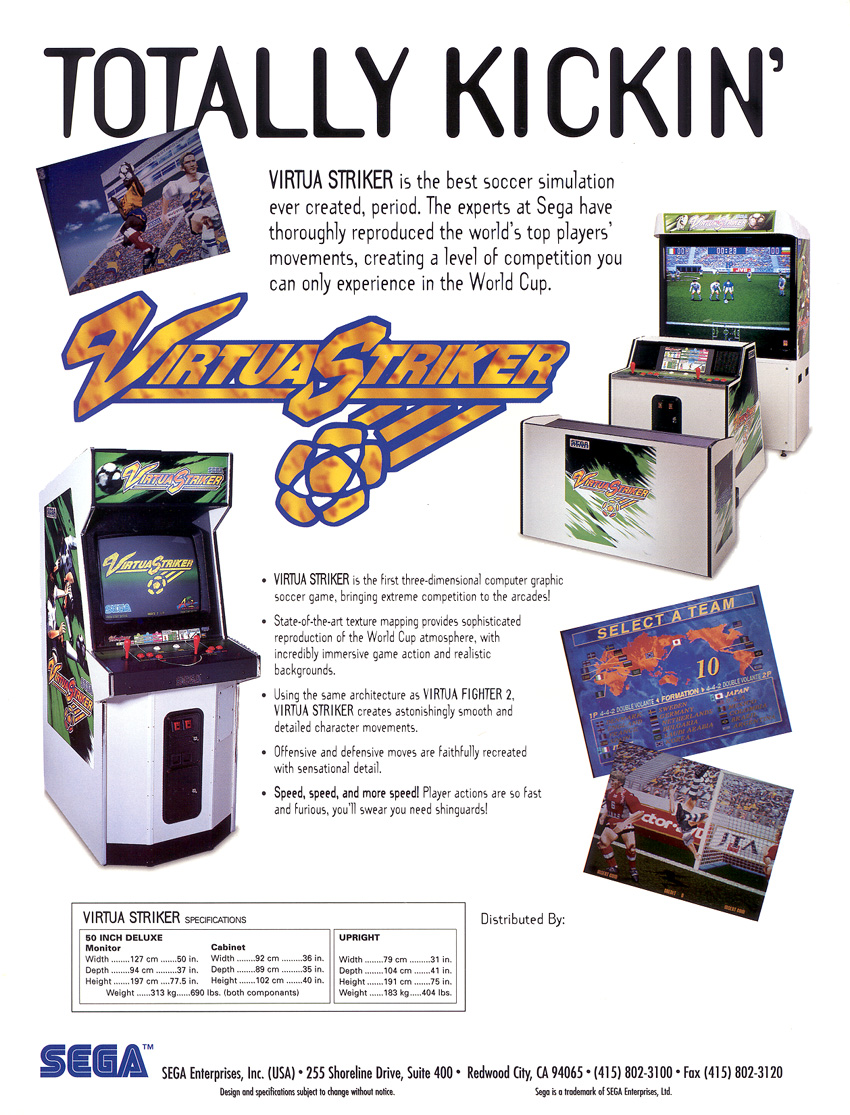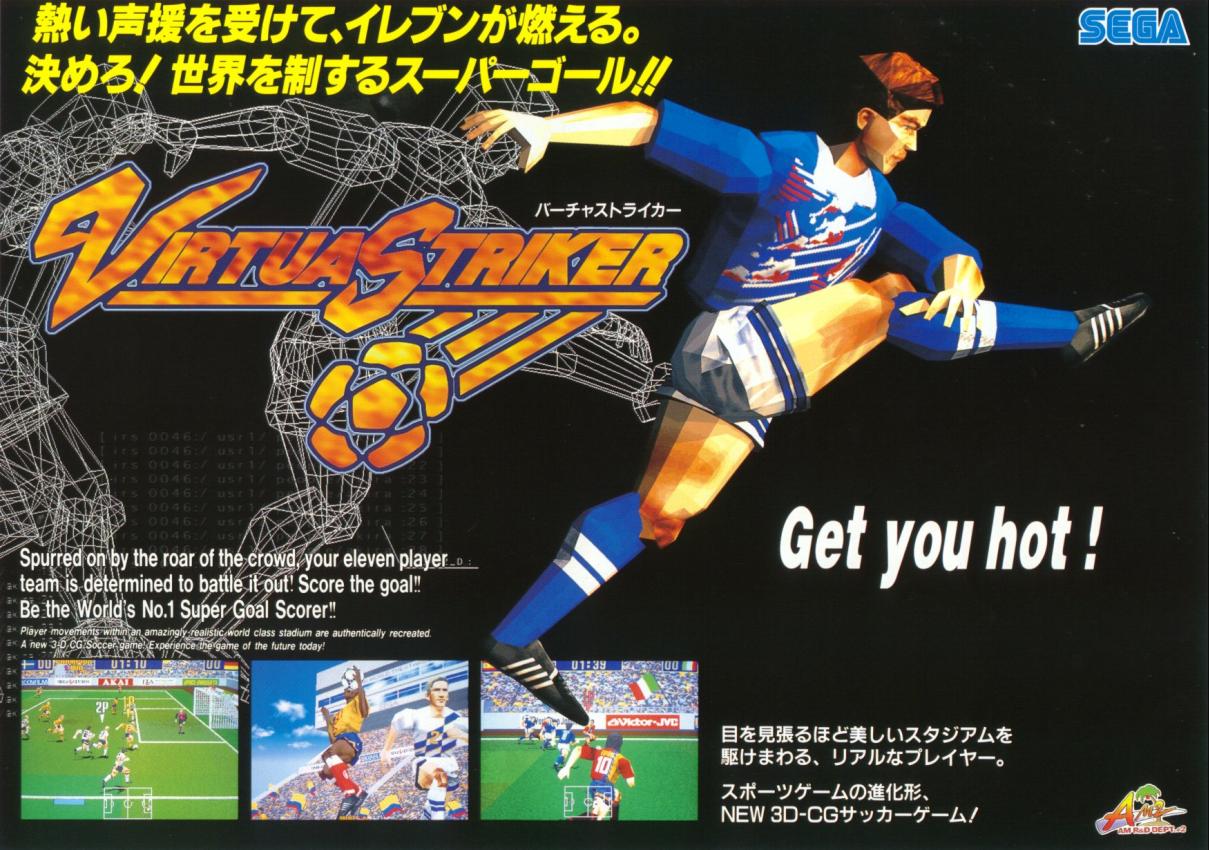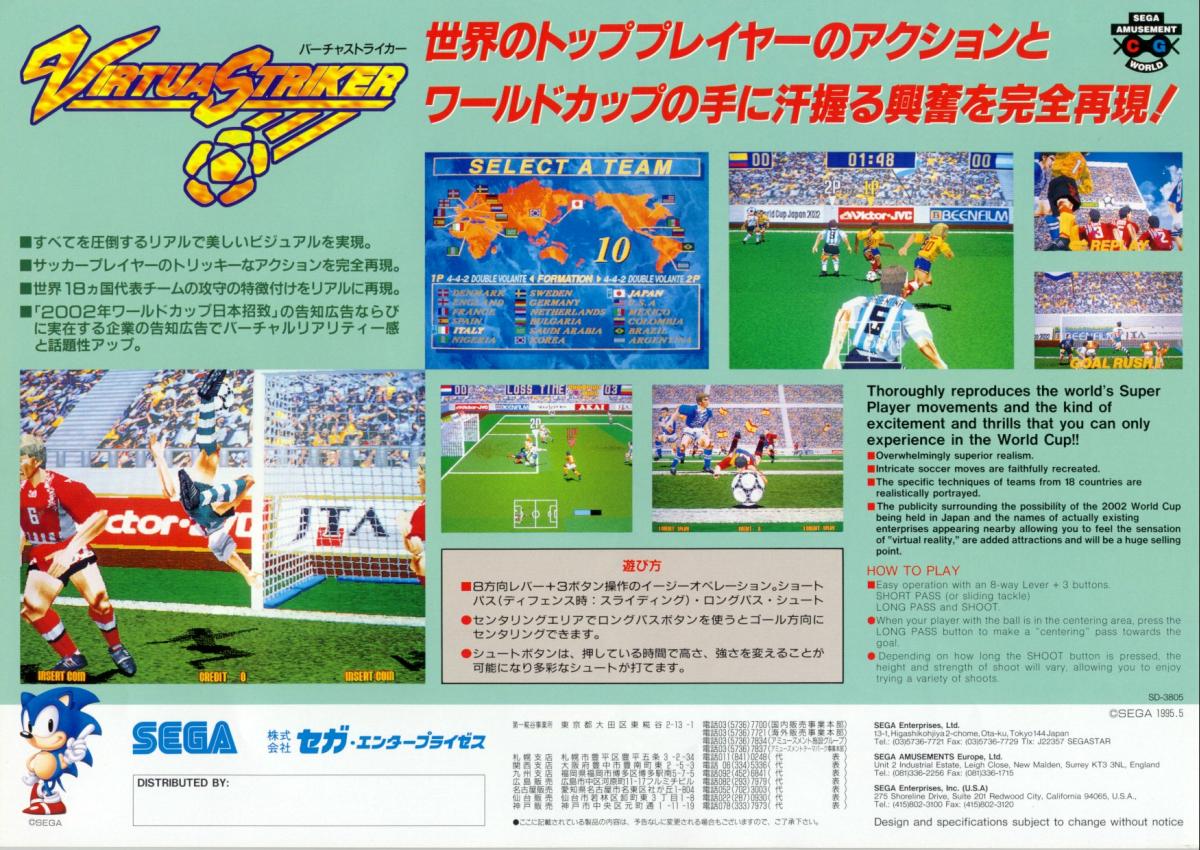Difference between revisions of "Virtua Striker"
From Sega Retro
m |
Hyperspeed34 (talk | contribs) |
||
| (35 intermediate revisions by 8 users not shown) | |||
| Line 1: | Line 1: | ||
{{Bob | {{Bob | ||
| bobscreen=VirtuaStriker title.png | | bobscreen=VirtuaStriker title.png | ||
| − | | | + | | publisher={{company|[[Sega]]}} |
| − | | | + | | developer={{company|[[Sega AM2]]|system=MOD2}} |
| − | | developer=[[Sega AM2]] | + | {{company|[[Sega R&D2 (2011-2015)|Sega R&D2]]|system=PS3,360}} |
| − | | system=[[Sega Model 2B CRX]], [[PlayStation | + | | system=[[Sega Model 2B CRX]], [[PlayStation 3]], [[Xbox 360]] |
| romsize={{Arcade}} 27.625 MB{{ref|http://mamedb.com/game/vstriker}} | | romsize={{Arcade}} 27.625 MB{{ref|http://mamedb.com/game/vstriker}} | ||
| sounddriver= | | sounddriver= | ||
| Line 10: | Line 10: | ||
| players=1 | | players=1 | ||
| genre=Sports | | genre=Sports | ||
| − | | releases={{ | + | | releases={{releasesArcade |
| − | | | + | | mod2_date_us=1995 |
| + | | mod2_date_jp=1995-05{{fileref|Sega Arcade History JP EnterBrain Book-1.pdf|page=136}} | ||
| + | | mod2_date_uk=1995 | ||
}} | }} | ||
{{releasesPS3 | {{releasesPS3 | ||
| − | | | + | | ps3_date_jp_d=2013-02-13{{ref|https://web.archive.org/web/20130227175009/http://www.jp.playstation.com:80/software/title/jp0177npjb00320_00virtuastriker000.html}} |
| − | | | + | | ps3_code_jp_d=NPJB-00320 |
| + | | ps3_rrp_jp_d=762 (''800''){{ref|https://web.archive.org/web/20130227175009/http://www.jp.playstation.com:80/software/title/jp0177npjb00320_00virtuastriker000.html}} | ||
| + | | ps3_rating_jp_d=a | ||
}} | }} | ||
{{releases360 | {{releases360 | ||
| − | | | + | | pts=yes |
| − | | | + | | 360_date_jp_d=2013-02-13{{ref|http://web.archive.org/web/20130217084327/http://marketplace.xbox.com:80/ja-JP/Product/Virtua-Striker/66acd000-77fe-1000-9115-d802584113cd}} |
| + | | 360_rrp_jp_d=800{{ref|http://web.archive.org/web/20130217084327/http://marketplace.xbox.com:80/ja-JP/Product/Virtua-Striker/66acd000-77fe-1000-9115-d802584113cd}} | ||
| + | | 360_rating_jp_d=a | ||
| + | | 360_date_jp_d_Otameshiban=2013-02-13{{ref|http://web.archive.org/web/20130217084327/http://marketplace.xbox.com:80/ja-JP/Product/Virtua-Striker/66acd000-77fe-1000-9115-d802584113cd}} | ||
| + | | 360_rrp_jp_d_Otameshiban=free | ||
| + | | 360_rating_jp_d_Otameshiban=a | ||
}} | }} | ||
| − | |||
}} | }} | ||
| − | + | '''''{{PAGENAME}}''''' (バーチャストライカー) is an arcade football game developed by [[Sega AM2]]. Like ''[[Virtua Racing]]'', ''[[Virtua Fighter]]'', ''[[Virtua Cop]]'' and later ''[[Virtua Tennis]]'', it is part of the ''Virtua'' series, and the first in the set of ''Virtua Striker'' games. ''Virtua Striker'' was released in 1995 for [[Sega Model 2B CRX]] hardware and is widely considered to be the first 3D football game ever to be released. | |
Unlike other games which contain the ''Virtua'' name, ''Virtua Striker'' was not ported to home consoles when it was new. It would not be made officially available to home users until nearly twenty years later, when an enhanced version was released for the Japanese [[PlayStation Network]] and [[Xbox Live Arcade]] in early 2013. | Unlike other games which contain the ''Virtua'' name, ''Virtua Striker'' was not ported to home consoles when it was new. It would not be made officially available to home users until nearly twenty years later, when an enhanced version was released for the Japanese [[PlayStation Network]] and [[Xbox Live Arcade]] in early 2013. | ||
| − | + | [[Sega Logistics Service]] announced it would end service on the arcade machines on March 31, 2017.{{fileref|SegaProductsTerminationAnnouncement 2016-11 JP.pdf}}{{fileref|SegaProductsTerminationAnnouncement 2016-12.pdf}} | |
| − | |||
| − | |||
| − | |||
| − | |||
| − | |||
| − | |||
| − | |||
| − | |||
| − | |||
| − | |||
| − | |||
| − | == | + | ==Gameplay== |
| + | ===Teams=== | ||
| + | {{InfoTable| | ||
| + | {{InfoRow | ||
| + | | title={{flag|DK}} Denmark | ||
| + | | desc= | ||
| + | }} | ||
| + | {{InfoRow | ||
| + | | title={{flag|England}} England | ||
| + | | desc= | ||
| + | }} | ||
| + | {{InfoRow | ||
| + | | title={{flag|FR}} France | ||
| + | | desc= | ||
| + | }} | ||
| + | {{InfoRow | ||
| + | | title={{flag|ES}} Spain | ||
| + | | desc= | ||
| + | }} | ||
| + | {{InfoRow | ||
| + | | title={{flag|IT}} Italy | ||
| + | | desc= | ||
| + | }} | ||
| + | {{InfoRow | ||
| + | | title={{flag|NG}} Nigeria | ||
| + | | desc= | ||
| + | }} | ||
| + | {{InfoRow | ||
| + | | title={{flag|SE}} Sweden | ||
| + | | desc= | ||
| + | }} | ||
| + | {{InfoRow | ||
| + | | title={{flag|DE}} Germany | ||
| + | | desc= | ||
| + | }} | ||
| + | {{InfoRow | ||
| + | | title={{flag|NL}} Netherlands | ||
| + | | desc= | ||
| + | }} | ||
| + | {{InfoRow | ||
| + | | title={{flag|BG}} Bulgaria | ||
| + | | desc= | ||
| + | }} | ||
| + | {{InfoRow | ||
| + | | title={{flag|SA}} Saudi Arabia | ||
| + | | desc= | ||
| + | }} | ||
| + | {{InfoRow | ||
| + | | title={{flag|KR}} Korea | ||
| + | | desc= | ||
| + | }} | ||
| + | {{InfoRow | ||
| + | | title={{flag|JP}} Japan | ||
| + | | desc= | ||
| + | }} | ||
| + | {{InfoRow | ||
| + | | title={{flag|US}} U.S.A. | ||
| + | | desc= | ||
| + | }} | ||
| + | {{InfoRow | ||
| + | | title={{flag|MX}} Mexico | ||
| + | | desc= | ||
| + | }} | ||
| + | {{InfoRow | ||
| + | | title={{flag|CO}} Colombia | ||
| + | | desc= | ||
| + | }} | ||
| + | {{InfoRow | ||
| + | | title={{flag|BR}} Brazil | ||
| + | | desc= | ||
| + | }} | ||
| + | {{InfoRow | ||
| + | | title={{flag|AR}} Argentina | ||
| + | | desc= | ||
| + | }} | ||
| + | {{InfoRow | ||
| + | | title=[[File:Sega.svg|20px]] F-C Sega | ||
| + | | desc= | ||
| + | }} | ||
| + | }} | ||
| + | |||
| + | ==History== | ||
| + | ===Development=== | ||
| + | ''{{PAGENAME}}'' was effectively conceived by [[Yu Suzuki]], who knew that longtime collaborator [[Satoshi Mifune]] was a fan of football{{intref|Interview: Satoshi Mifune (2002-02-06) by Sega.jp | ||
| + | }}{{ref|https://web.archive.org/web/20231130002500/https://www.4gamer.net/games/999/G999905/20180418132/}}. Suzuki believed Sega had a chance to secure the video game football market and make a profit in Europe, where the genre usually had success{{ref|https://web.archive.org/web/20231130002500/https://www.4gamer.net/games/999/G999905/20180418132/}}. Mifune was against the idea, viewing football as just a hobby of his, instead developing racing games such as ''[[GP Rider]]'' and ''[[F1 Exhaust Note]]'' throughout his career{{ref|https://web.archive.org/web/20231130002500/https://www.4gamer.net/games/999/G999905/20180418132/}}. However, by early 1994{{magref|smjp|1995-04|118}}, he felt that vehicle-based games were oversaturating the market, so took up Suzuki's offer to pivot genres{{magref|smjp|1995-04|118}}{{ref|https://web.archive.org/web/20231130002500/https://www.4gamer.net/games/999/G999905/20180418132/}}. It ended up as a stressful development for him which faced cancellation several times, and Mifune threatened to never make a football game again if it flopped{{ref|https://web.archive.org/web/20231130002500/https://www.4gamer.net/games/999/G999905/20180418132/}}. | ||
| + | |||
| + | Of the 12-person development team under his direction, 4 of the developers had previously worked with Satoshi Mifune on ''[[F1 Super Lap]]''. The game was created in a branch office at [[Sega AM2]], separate from the team developing ''[[Daytona USA]]''{{ref|https://web.archive.org/web/20231130002500/https://www.4gamer.net/games/999/G999905/20180418132/}}. One ''Daytona USA'' developer, graphic designer [[Hiroyuki Nakagomi]], joined the ''Virtua Striker'' team fairly early on as the only other pre-established football fan{{ref|https://web.archive.org/web/20231130002500/https://www.4gamer.net/games/999/G999905/20180418132/}}. | ||
| + | |||
| + | Development began on the [[Model 1]] board, which proved challenging with rendering 22 players on the screen at the same time{{ref|https://web.archive.org/web/20231130002500/https://www.4gamer.net/games/999/G999905/20180418132/}}. After doing extensive sales research, Mifune was able to increase the projected sales twofold, honing in on the game's 2-player competitive appeal{{ref|https://web.archive.org/web/20231130002500/https://www.4gamer.net/games/999/G999905/20180418132/}}. The technical difficulties were then alleviated by switching to the more powerful [[Model 2]] board, but the sales department still expected the game would underperform and AM2 would be better off cancelling it{{ref|https://web.archive.org/web/20231130002500/https://www.4gamer.net/games/999/G999905/20180418132/}}. Mifune, who had been planning to begin location testing 2 months when he received the information, persisted and was able to get Yu Suzuki to ask the whole team if they wanted to continue until the location test or drop it then and there{{ref|https://web.archive.org/web/20231130002500/https://www.4gamer.net/games/999/G999905/20180418132/}}. The team decided to keep making the game and managed to score a location test at [[Ikebukuro GiGO]], which proved successful enough to continue development{{magref|smjp|1995-04|118}}{{ref|https://web.archive.org/web/20231130002500/https://www.4gamer.net/games/999/G999905/20180418132/}}. | ||
| + | |||
| + | The game was rumoured to exist for some time{{magref|ssmjp|1995-04|118}} before being officially announced at [[AOU Show 1995]]{{magref|saturnfan|1995-04|058}}. | ||
| + | |||
| + | ===Location testing=== | ||
| + | {{LocationTestTable| | ||
| + | {{LocationTestRow | ||
| + | | venue=[[Ikebukuro GiGO]]{{ref|https://web.archive.org/web/20231130002500/https://www.4gamer.net/games/999/G999905/20180418132/}} | ||
| + | | start= | ||
| + | | end= | ||
| + | }} | ||
| + | }} | ||
| + | The location testing took place over 9 days{{magref|smjp|1995-04|118}}. | ||
| + | |||
| + | ===Achievements=== | ||
| + | {{mainArticle|{{PAGENAME}}/Achievements}} | ||
| + | |||
| + | ==Production credits== | ||
| + | {{mainArticle|{{PAGENAME}}/Production credits}} | ||
| + | |||
| + | ==Magazine articles== | ||
| + | {{mainArticle|{{PAGENAME}}/Magazine articles}} | ||
| + | |||
| + | ==Promotional material== | ||
| + | {{gallery | ||
| + | |{{gitem|VirtuaStriker Model2 US Flyer1.jpg|Model2 US Flyer Page1}} | ||
| + | |{{gitem|VirtuaStriker Model2 US Flyer2.jpg|Model2 US Flyer Page2}} | ||
| + | |{{gitem|VirtuaStriker Model2 JP Flyer1.jpg|Model2 JP Flyer Page1}} | ||
| + | |{{gitem|VirtuaStriker Model2 JP Flyer2.jpg|Model2 JP Flyer Page2}} | ||
| + | }} | ||
| + | |||
| + | ==Photo gallery== | ||
<gallery> | <gallery> | ||
| − | + | VirtuaStriker Arcade Cabinet Upright.jpg|Upright cabinet | |
| − | + | VirtuaStriker Arcade Cabinet Deluxe.jpg|Deluxe cabinet | |
</gallery> | </gallery> | ||
| − | ==Physical | + | ==Physical scans== |
{{ratings | {{ratings | ||
| − | | icon= | + | | icon=MOD2 |
| − | |||
| − | |||
| gamesworld=87 | | gamesworld=87 | ||
| gamesworld_source={{num|11|page=85}} | | gamesworld_source={{num|11|page=85}} | ||
}} | }} | ||
| − | |||
| − | |||
| − | |||
| − | |||
| − | |||
| − | |||
| − | |||
| − | |||
| − | |||
| − | |||
| − | |||
| − | |||
| − | ==External | + | ==External links== |
| − | *''{{PAGENAME}}'' on Xbox Marketplace: [http://marketplace.xbox.com/ja-JP/Product/Virtua-Striker/66acd000-77fe-1000-9115-d802584113cd JP] | + | * ''{{PAGENAME}}'' on Xbox Marketplace: [http://marketplace.xbox.com/ja-JP/Product/Virtua-Striker/66acd000-77fe-1000-9115-d802584113cd JP] |
| − | {{ | + | * ''{{PAGENAME}}'' on PlayStation.com: [http://www.jp.playstation.com/software/title/jp0177npjb00320_00virtuastriker000.html JP] |
| + | * ''{{PAGENAME}}'' on PlayStation Store: [https://store.playstation.com/#!/ja-jp/%e3%82%b2%e3%83%bc%e3%83%a0/virtua-striker/cid=JP0177-NPJB00320_00-VIRTUASTRIKER000 JP] | ||
| + | *''[https://www.4gamer.net/games/999/G999905/20180418132/ Video Game Storytellers Part 5: The Journey of Satoshi Mifune and Hiroyuki Nakagomi, the Creators of Virtua Striker]'' article by [[Fumio Kurokawa]] at ''[https://www.4gamer.net 4Gamer.net]'' (Japanese) | ||
| + | |||
| + | ==References== | ||
| + | <references/> | ||
| + | |||
| + | {{VirtuaStrikerOmni}} | ||
{{VirtuaStriker}} | {{VirtuaStriker}} | ||
| − | |||
| − | |||
[[Category:Model 2B CRX games]] | [[Category:Model 2B CRX games]] | ||
Latest revision as of 19:49, 13 May 2024
| Virtua Striker | ||||||||||||||||||||||||||||||||
|---|---|---|---|---|---|---|---|---|---|---|---|---|---|---|---|---|---|---|---|---|---|---|---|---|---|---|---|---|---|---|---|---|
| System(s): Sega Model 2B CRX, PlayStation 3, Xbox 360 | ||||||||||||||||||||||||||||||||
| Publisher: Sega | ||||||||||||||||||||||||||||||||
| Developer: Sega AM2 Sega R&D2 | ||||||||||||||||||||||||||||||||
| Genre: Sports | ||||||||||||||||||||||||||||||||
| Number of players: 1 | ||||||||||||||||||||||||||||||||
|
Virtua Striker (バーチャストライカー) is an arcade football game developed by Sega AM2. Like Virtua Racing, Virtua Fighter, Virtua Cop and later Virtua Tennis, it is part of the Virtua series, and the first in the set of Virtua Striker games. Virtua Striker was released in 1995 for Sega Model 2B CRX hardware and is widely considered to be the first 3D football game ever to be released.
Unlike other games which contain the Virtua name, Virtua Striker was not ported to home consoles when it was new. It would not be made officially available to home users until nearly twenty years later, when an enhanced version was released for the Japanese PlayStation Network and Xbox Live Arcade in early 2013.
Sega Logistics Service announced it would end service on the arcade machines on March 31, 2017.[5][6]
Contents
Gameplay
Teams
History
Development
Virtua Striker was effectively conceived by Yu Suzuki, who knew that longtime collaborator Satoshi Mifune was a fan of football[7][8]. Suzuki believed Sega had a chance to secure the video game football market and make a profit in Europe, where the genre usually had success[8]. Mifune was against the idea, viewing football as just a hobby of his, instead developing racing games such as GP Rider and F1 Exhaust Note throughout his career[8]. However, by early 1994[9], he felt that vehicle-based games were oversaturating the market, so took up Suzuki's offer to pivot genres[9][8]. It ended up as a stressful development for him which faced cancellation several times, and Mifune threatened to never make a football game again if it flopped[8].
Of the 12-person development team under his direction, 4 of the developers had previously worked with Satoshi Mifune on F1 Super Lap. The game was created in a branch office at Sega AM2, separate from the team developing Daytona USA[8]. One Daytona USA developer, graphic designer Hiroyuki Nakagomi, joined the Virtua Striker team fairly early on as the only other pre-established football fan[8].
Development began on the Model 1 board, which proved challenging with rendering 22 players on the screen at the same time[8]. After doing extensive sales research, Mifune was able to increase the projected sales twofold, honing in on the game's 2-player competitive appeal[8]. The technical difficulties were then alleviated by switching to the more powerful Model 2 board, but the sales department still expected the game would underperform and AM2 would be better off cancelling it[8]. Mifune, who had been planning to begin location testing 2 months when he received the information, persisted and was able to get Yu Suzuki to ask the whole team if they wanted to continue until the location test or drop it then and there[8]. The team decided to keep making the game and managed to score a location test at Ikebukuro GiGO, which proved successful enough to continue development[9][8].
The game was rumoured to exist for some time[10] before being officially announced at AOU Show 1995[11].
Location testing
| Venue | Start date | End date | Comments |
|---|---|---|---|
| Ikebukuro GiGO[8] |
The location testing took place over 9 days[12].
Achievements
- Main article: Virtua Striker/Achievements.
Production credits
- Main article: Virtua Striker/Production credits.
Magazine articles
- Main article: Virtua Striker/Magazine articles.
Promotional material
Photo gallery
Physical scans
| Sega Retro Average | ||||||||||||||
|---|---|---|---|---|---|---|---|---|---|---|---|---|---|---|
|
| 85 | |
|---|---|
| Based on 2 reviews | |
External links
- Virtua Striker on Xbox Marketplace: JP
- Virtua Striker on PlayStation.com: JP
- Virtua Striker on PlayStation Store: JP
- Video Game Storytellers Part 5: The Journey of Satoshi Mifune and Hiroyuki Nakagomi, the Creators of Virtua Striker article by Fumio Kurokawa at 4Gamer.net (Japanese)
References
- ↑ Sega Arcade History, Enterbrain, page 136
- ↑ 2.0 2.1 http://www.jp.playstation.com:80/software/title/jp0177npjb00320_00virtuastriker000.html (Wayback Machine: 2013-02-27 17:50)
- ↑ 3.0 3.1 3.2 Xbox LIVE Marketplace (ja-JP; Virtua-Striker/66acd000-77fe-1000-9115-d802584113cd) (Wayback Machine: 2013-02-17 08:43)
- ↑ http://mamedb.com/game/vstriker
- ↑ File:SegaProductsTerminationAnnouncement 2016-11 JP.pdf
- ↑ File:SegaProductsTerminationAnnouncement 2016-12.pdf
- ↑ Interview: Satoshi Mifune (2002-02-06) by Sega.jp
- ↑ 8.00 8.01 8.02 8.03 8.04 8.05 8.06 8.07 8.08 8.09 8.10 8.11 8.12 https://www.4gamer.net/games/999/G999905/20180418132/ (Wayback Machine: 2023-11-30 00:25)
- ↑ 9.0 9.1 9.2 ', "" (; ), page 118
- ↑ Sega Saturn Magazine, "April 1995" (JP; 1995-03-08), page 118
- ↑ Saturn Fan, "1995 April" (JP; 1995-03-08), page 058
- ↑ Saturn Fan, "1995 April" (JP; 1995-03-08), page 118
- ↑ Computer & Video Games, "September 1995" (UK; 1995-08-11), page 74
- ↑ Next Generation, "October 1995" (US; 1995-09-19), page 132
| Virtua Striker | |
|---|---|
|
Main page | Comparisons | Achievements | Credits | Development | Magazine articles | Reception
| |
| Virtua Striker series | |
|---|---|
| Virtua Striker (1994) | Virtua Striker 2 (Version '98 | '99 | 2000 | 2000.1) (1997-2000) | Virtua Striker 3 (Ver. 2002) (2001-2002) | Virtua Striker 4 (Ver. 2006) (2005-2006) | |
| Virtua Striker related media | |
| Virtua Striker & Virtua Striker 2 (1997) | |
| Virtua Striker 2 Version '98 Official Guide (1998) | Virtua Striker 2 Ver. 2000.1 Kanzen Kouryaku Guide (2000) | Virtua Striker 3 Ver. 2002 Road to International Cup Kyuukyoku Guide (2002) | |
- 1 player games
- All arcade games
- Model 2 games
- 1995 Model 2 games
- All 1995 games
- JP PlayStation 3 games
- All JP games
- PlayStation 3 games
- All sports games
- 2013 PlayStation 3 games
- All 2013 games
- Download-only PlayStation 3 games
- JP Xbox 360 games
- Xbox 360 games
- 2013 Xbox 360 games
- Download-only Xbox 360 games
- Use romtable template
- All games
- Old-style rating (gamesworld)
- Rating without PDF source
- Update ratings template
- 1 old ratings
- Virtua Striker
- Virtua Striker (franchise)
- Model 2B CRX games
